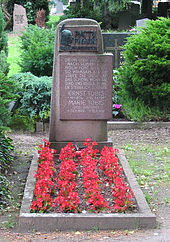Patty Frank
Patty Frank alias Eisenarm alias Isto Maza, real name Ernst Tobis , (born January 19, 1876 in Vienna , † August 23, 1959 in Radebeul ) was a German artist , Indian researcher and museum director.
Life
His grandfather was a porcelain painter, his father a porcelain dealer. The Tobis family originally came from Bohemia and migrated to Vienna from the area around Karlsbad . When the only boy Ernst was 13 years old, his father stayed in Vienna and continued to go about his business as a porcelain dealer, the mother moved with the children to Frankfurt am Main , where daughter Gabriele, the eldest, studied singing and later became the first coloratura soprano made a name for opera. The mother, who was determined to curb her offspring's thirst for adventure, trained him to be an art gardener.
The American hiking group Buffalo-Bill 's Wild West Show with its 200 Indians and cowboys, wild horses and buffalos was a guest in Frankfurt for several days, in the palm garden of all places , and the gardening apprentice Tobis was one of the servants who had to make sure that the Visitors did not devastate the green spaces. When the enthusiastic boy learned that a stable boy was wanted, he ran away from home. His mother finally found him in Strasbourg and brought him back. The only souvenir was a pair of original moccasins that he had begged from a member of the troupe and that became the basis of his later world-famous collection. In his free time, he met like-minded people in the “Helvetia” gymnastics club and learned the basic concepts of parterrearobatics ; this was the beginning of his career as an artist.
Patty Frank was the co-founder and long-time administrator of the Karl May and Indian Museum of the Karl May Foundation in Radebeul, which opened in 1928 . Karl May's widow Klara needed a custodian for the sensible use of her husband's estate and the establishment of a museum. Frank was the right man for that. She also needed additional material that Frank had collected on his tours.
His apartment with a lifelong right of residence was in the " Villa Bärenfett ", which Klara May had built for him in 1926 in the style of a log cabin. For 30 years, until shortly before his death, he explained the life and customs of the Indians to interested people. The visitor statistics spoke of 300,000 guests per year. He also wrote a number of books that achieved larger editions: How the Indians Lived and Died , The Indian Battle of the Little Big Horn and A Life Under the Spell of Karl May .
Patty Frank's grave is not far from Karl May 's grave in the cemetery in Radebeul. Two years after his death, his wife, whom he married when he was 65, also died. Marie Barthel was Klara May's housekeeper for 20 years.
Fonts
- The Indian Battle at Little Bighorn, Karl May Yearbook 1926
- How I got my first scalp, Karl-May-Jahrbuch 1929
- An attack on the log cabin, Karl May yearbook 1930
- The hunt for the buffalo skin, Karl May yearbook 1931
- Karl May's last prisoner, Karl May yearbook 1932
- The Indian battle in Stuttgart, Karl May yearbook 1933
- A life under the spell of Karl May, Karl-May-Verlag, 1935 (contains four of the above texts)
- This is how the Indians lived and died, 11-part series of articles in the weekly newspaper Die Grüne Post , 1941
- Wild West. Life and death of the North American Indians, 1951 (with drawings by Zdenek Burian)
- The Indian Battle of Little Big Horn, 1957
literature
- Wolfgang Seifert: Patty Frank - the circus, the Indians, the Karl May Museum. 1998 (biography)
Web links
- Heike Wolter: Frank, Patty (aka Ernst Tobis) . In: Institute for Saxon History and Folklore (Ed.): Saxon Biography .
- Karl May Museum Radebeul
- Literature by and about Patty Frank in the catalog of the German National Library
- Article about Patty Frank ("Wiener Zeitung")
- Entry in the karl-may-wiki .
| personal data | |
|---|---|
| SURNAME | Frank, Patty |
| ALTERNATIVE NAMES | Tobis, Ernst (real name) |
| BRIEF DESCRIPTION | German artist, Indian researcher and museum director |
| DATE OF BIRTH | January 19, 1876 |
| PLACE OF BIRTH | Vienna |
| DATE OF DEATH | 23rd August 1959 |
| Place of death | Radebeul |


